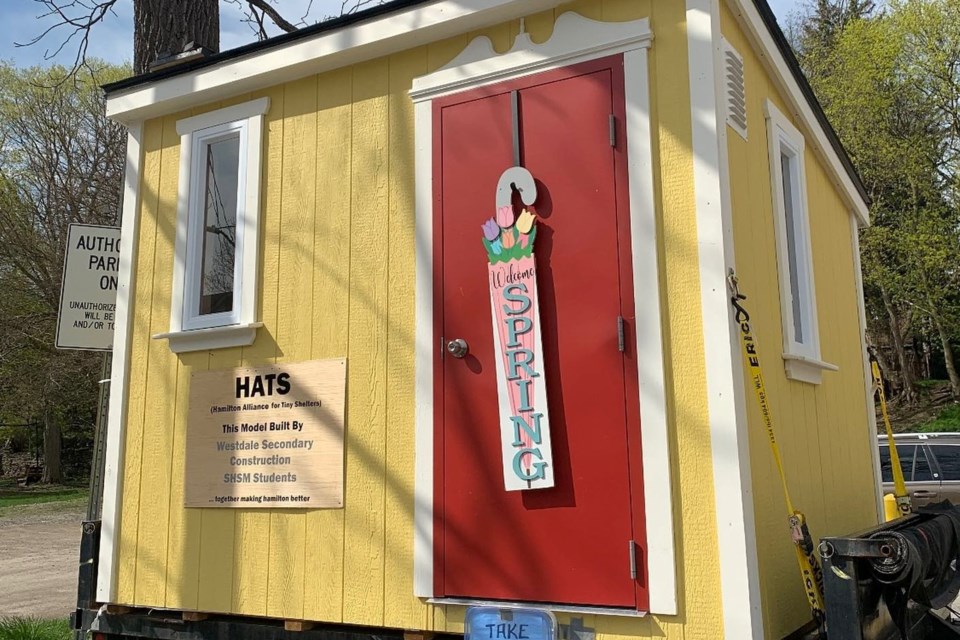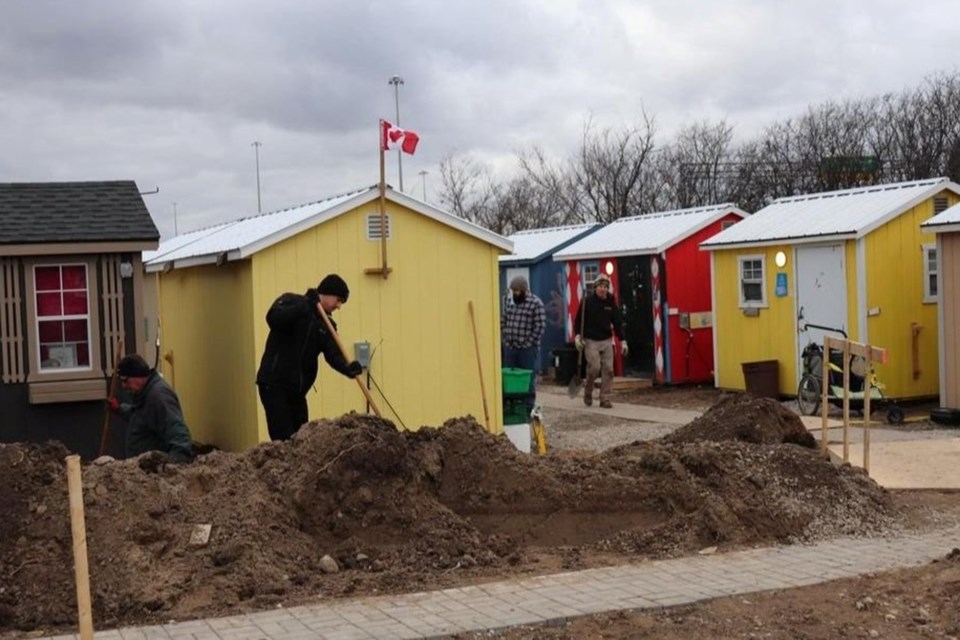Will tiny home communities help the homeless or is it better to invest the money into affordable housing? Can municipalities do both?
Often seen as a temporary and costly solution to the homelessness crisis, tiny home communities are popping up around Ontario, a potential solution to the growing number of people who are living without shelter.
But they are often regarded as a Band-Aid solution, a temporary fix that won’t solve the issues, or would create new ones.
However, Tony Stortz, who has worked with several of the burgeoning communities told Sudbury.com, “When you're bleeding out, and the hospitals are three hours away, you need a bandage to get there.”
He said it’s about emergency care. “Permanent, sustainable, affordable housing, even with record levels of investment, is going to take years. We need bandages, because people are bleeding right now and their lives matter.”
Stortz is the founder of Better Street, a consulting firm who has helped Kitchener/Waterloo (his home town) and Hamilton, as well as other cities in Canada, to support tiny home communities with training, fundraising, and research.
He said the challenge in creating tiny home communities doesn’t always come from the logistics of the buildings themselves.
“The easiest part about building a tiny home community is building a tiny home community. The hardest part is having anybody allow you to build a tiny home community,” he told Sudbury.com.
Stortz also wrote a book on the matter. You can find A Home of Their Own: A Guide to Building Tiny Homes free here.
The Communities
The tiny home communities across Canada, including those in Fredericton, NB, tend to have the same features: several 8x10, shed-like structures that contain a bed and dresser, electricity, heating and air conditioning. Each unit comes in at approximately $15,000-$21,000 depending on material costs.
Washroom, kitchen and laundry facilities are contained in a communal building, which Stortz said helps with cost, safety, and requires community members to interact with each other and the staff and volunteers. This is a chance to offer any number of social services to help the residents transition to more permanent housing later.
Stortz said the tiny communities are a temporary dam until upstream issues are resolved.
“Homelessness is like a river, fed by all these streams, these upstream issues,” he said, noting the lack of affordable housing, stagnant income supplements like Ontario Works and ODSP, as well as the opioid crisis, trauma and intergenerational trauma. “Those of us who work in homelessness, we're downstream of these massive problems; so when someone says, ‘well, this doesn't solve all the problems,’ well, of course it doesn't, there's like nine problems at play here.”
In Sudbury, the toxic drug crisis factors in the cause of homelessness, and must be considered in any solutions, said Stortz. “They both have to go hand in hand,” he said. “You provide someone a place where they aren't always in such terrible pain, and then you can work with them to let go of the things that they use to manage that pain.”
Who is homeless in Sudbury?
There is a lack of recent data, but based on the 2021 Point-in-Time count, a count of people who are homeless over a 24-hour period, the homeless population is mostly single adults, identifying as men, between the ages of 25 and 59. Most live on social services income.
At the time, a large proportion of those who were homeless came from out of town. Now, that has changed, said Gail Spencer in a previous interview with Sudbury.com. Spencer is the city’s manager of housing stability and homelessness and said the majority of people now on the list are from Sudbury.
Of the 132 respondents to the Point-in-Time count, 80 per cent reported having a substance use issue, 66 per cent reported having a mental health issue, 45 per cent reported having a learning or cognitive limitation, 35 per cent reported having an illness or medical condition and 33 per cent reported having a physical limitation.
The most common challenges posed to accessing housing, said the respondents, was rental amounts that are too high with income levels too low to cover.
Tiny Homes in Sudbury
In Sudbury, city staff are busy working on a report, the result of a motion from Ward 5 Coun. Mike Parent and Ward 4 Coun. Pauline Fortin, aiming to end homelessness by 2030.
Tyler Cambell told Sudbury.com that the focus of council direction has been affordable housing, including the Lorraine Street transitional housing project.
Of the new council motion, Campbell said a report would be back to council in the first quarter of 2024.
“We're anticipating in March or April a holistic approach to the whole piece, looking at how we achieve functional zero and homelessness in the community by 2030.”
While he was unable to speak to whether tiny home communities could work in Sudbury, he noted that they have watched “different jurisdictions try it out and there's been mixed results,” he said, and the city hopes to investigate why.
Campbell also spoke of Iain De Jong of OrgCode Consulting, who presented the Greater Sudbury Encampment Response Guide to city council on Oct. 15, 2021.
In it, De Jong stated “while tiny homes may have a place in the broader continuum of housing options for a community, (though this needs to be carefully scrutinized, he added) tiny homes have not proven effective at ending encampments.”
He added that tiny homes can be difficult to size and service, depending on their location, and “can be more expensive to build, site and service on a per-square-foot basis compared to other forms of multi-unit residential housing.”
Sudbury.com asked Stortz to respond to this.
Stortz said these communities are not the end-all fix, “but I think it is short sighted to say that they have no part in a solution.”
He said that’s because the status quo is unacceptable to him.
“People are freezing in the street; people are criminalized because they can't afford rent,” he said. “These homes are a high-speed, low-capital solution that gets people indoors, supported and safe.”
Many, like Peterborough’s new community, we’re up and running in six months.
Peterborough
The most recent community to open is the Modular Bridge Housing Community in Peterborough, which completed construction on their units on Nov. 16, and were welcoming new residents on Nov. 27. The goal there was to provide shelter for 50 people who are currently experiencing homelessness.
Located on site is a service hub with security and staff support on site at all times. Elizabeth Fry Society will operate the site on behalf of the City of Peterborough.
The community is located in the municipal parking lot with municipal support, replacing an encampment that once grew there. There is now another 70-person-encampment across the street, as more people have become homeless than there are tiny homes.
In Peterborough, community members are charged rent geared to their income, which is all from government income supplements.
Kitchener/Waterloo
There are two tiny home communities in The Kitchener/Waterloo area, the first being A Better Tent City (ABTC), run by a non-profit board, whose organizers lobbied extensively to their municipality, said Stortz.
Although they have had to move the community twice over the past few years, ABTC is now located on land owned partly by the Waterloo Region District School Board and partly by the City of Kitchener. It also houses an administrative building.
The washroom and showers are located in a shipping container. Three connected portables contain the kitchen, dining, laundry and more washrooms.
Most of the residents are on the Ontario Works Program or the Ontario Disability Support Program and through those programs they are entitled to a shelter allowance, which is directed to the communities through the municipality.
Seeing the benefits, the region of Waterloo then replicated the idea on another site.
Hamilton
Though the Hamilton Alliance for Tiny Shelters (HATS) is still seeking a site, they are working on a targeted timeline of mid-2024.
Dan Bednis, board chair of HATS and former resident of Sudbury, told Sudbury.com their plan is 25 insulated 8x12 cabins, with the same amenities as the others. More than $400,000 has been raised through private donations.
They have specifically stated no guests will be allowed, said Bednis.
Sudbury.com spoke to Ray Landry of Sudbury’s Homelessness Network in February to learn why so many people who had been housed were returning to the by-name list, a list of those in need of housing. Landry said those who are newly housed are often intimidated into letting others move in, to their own detriment.
That is why, said Bednis and Stortz, it is important to speak to the potential residents as much as stakeholders when creating these projects.
“If I work in seven communities, I want to see seven different models, because each model needs to reflect the unique values and history of that community,” said Stortz.
While it remains to be seen what will come of these communities, and the report that city staff will present to council this spring, it is clear that there is a need for more diverse housing options in Ontario, said Strotz, and that need is a desperate one.
Jenny Lamothe covers vulnerable and marginalized communities for Sudbury.com.


